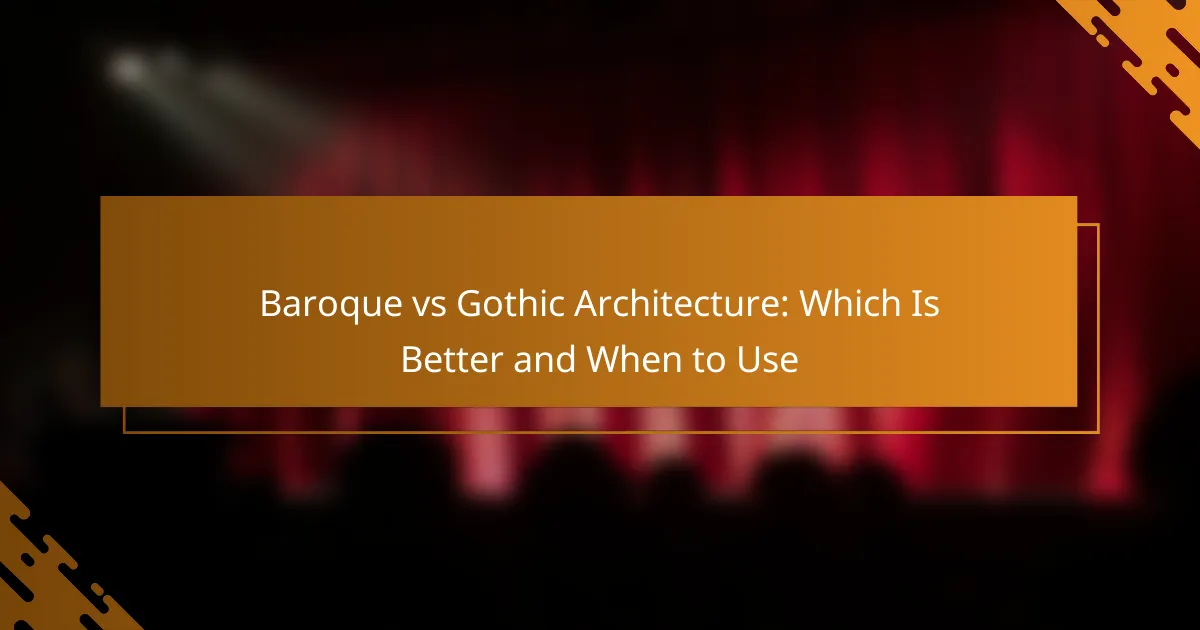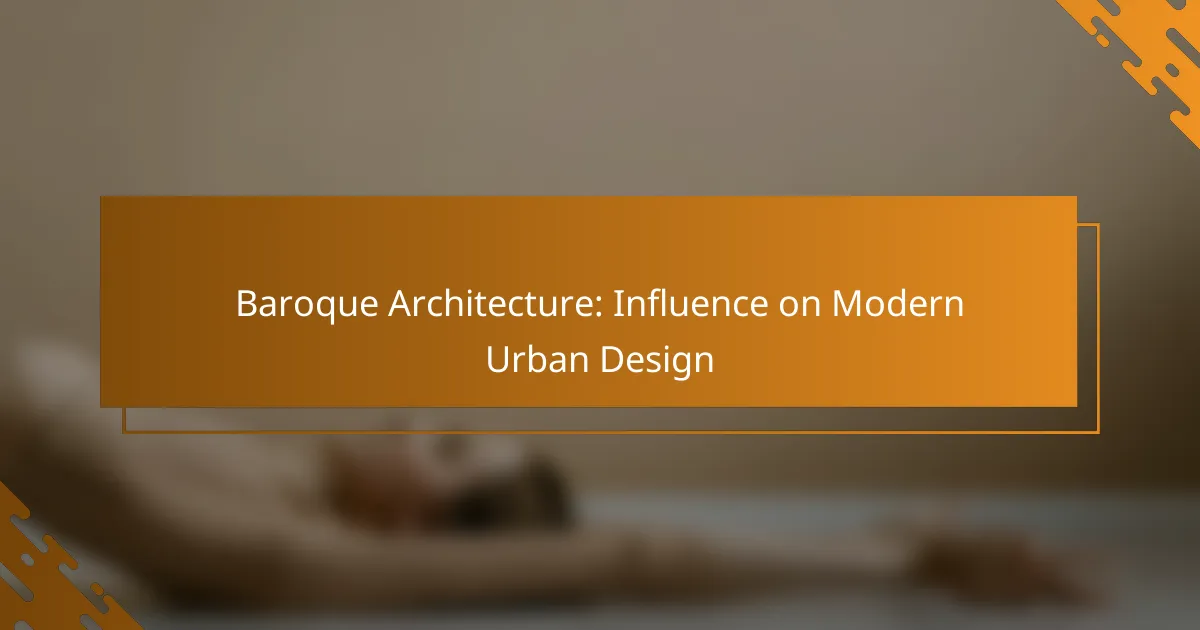Baroque and Gothic architecture offer distinct styles that cater to different design intentions and atmospheres. While Baroque is celebrated for its opulent details and dramatic flair, Gothic architecture excels in creating soaring spaces filled with light, ideal for evoking a sense of spirituality. Understanding the unique characteristics of each style can help you choose the right one for your project, whether aiming for grandeur or a serene, awe-inspiring environment.
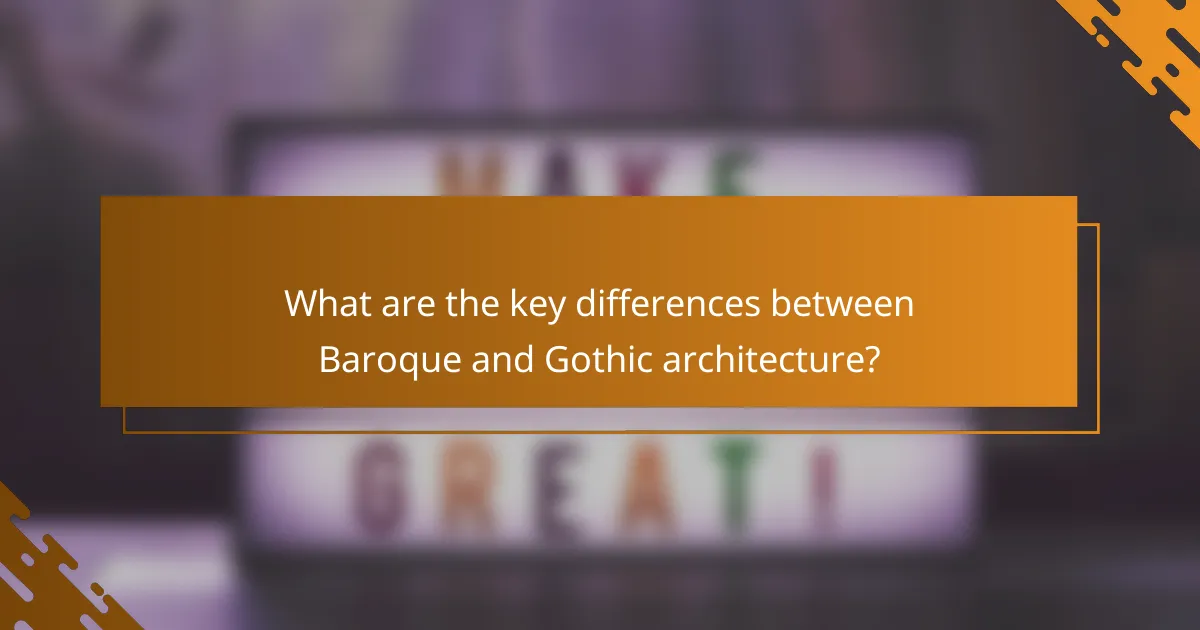
What are the key differences between Baroque and Gothic architecture?
Baroque and Gothic architecture differ significantly in style, purpose, and visual impact. Baroque is known for its elaborate details and dramatic expressions, while Gothic architecture is characterized by its emphasis on height and light.
Baroque architecture features ornate details
Baroque architecture is distinguished by its intricate decorations and elaborate designs. This style often includes grandiose elements such as sculptures, frescoes, and elaborate moldings that create a sense of movement and richness. Buildings like St. Peter’s Basilica in Vatican City exemplify the ornate nature of Baroque architecture.
When considering Baroque for a project, aim for bold colors and dramatic contrasts. This style is ideal for spaces meant to impress or evoke emotion, such as theaters or churches.
Gothic architecture emphasizes verticality and light
Gothic architecture is marked by its towering structures and extensive use of stained glass, which allows natural light to flood interiors. The vertical lines and pointed arches create an upward thrust, drawing the eye toward the heavens. Notable examples include Notre-Dame Cathedral in Paris.
For projects that require a sense of openness and spirituality, Gothic elements can be effectively utilized. Consider incorporating high ceilings and large windows to enhance the feeling of lightness.
Baroque is characterized by grandeur and drama
The grandeur of Baroque architecture is evident in its scale and theatricality. This style often combines different artistic disciplines, including painting and sculpture, to create a cohesive and immersive experience. The use of dramatic lighting and shadow adds to the overall effect.
When designing with Baroque elements, focus on creating focal points that capture attention, such as grand staircases or elaborate altars. This style works well in settings where you want to convey opulence and artistic expression.
Gothic includes pointed arches and ribbed vaults
Key features of Gothic architecture include pointed arches and ribbed vaults, which not only enhance structural integrity but also contribute to the aesthetic appeal. These elements allow for taller buildings and larger windows, which are essential for the characteristic light-filled interiors.
Incorporating pointed arches and ribbed vaults can provide a sense of historical authenticity and elegance. This approach is particularly effective in religious or civic buildings where a connection to tradition is valued.
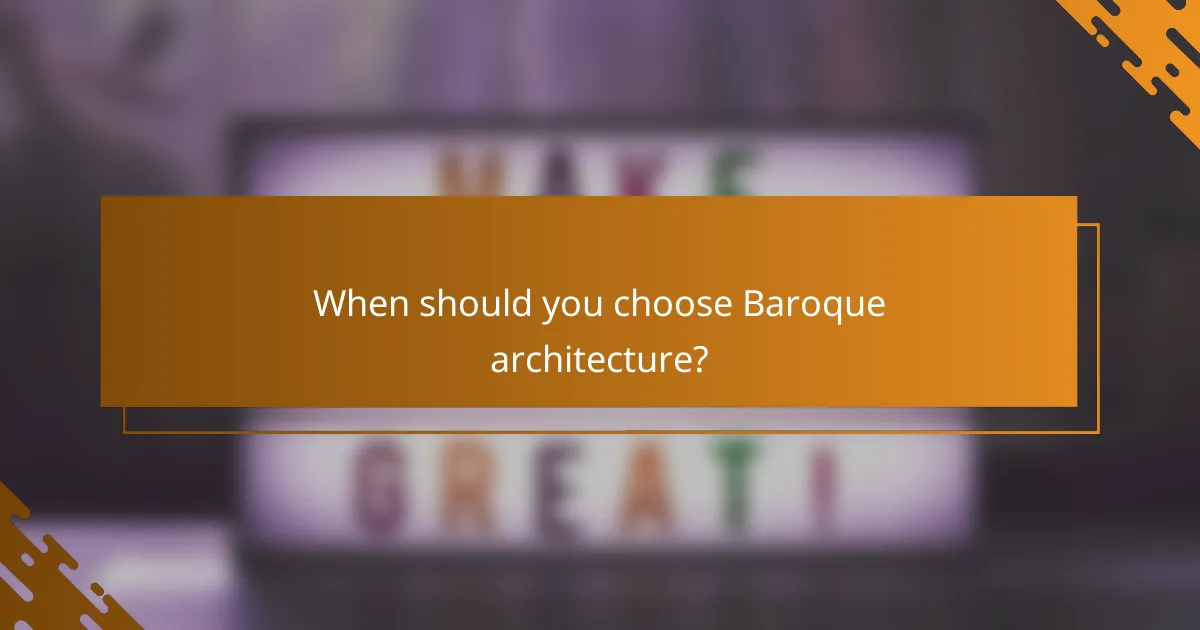
When should you choose Baroque architecture?
Baroque architecture is ideal when you want to create a sense of grandeur and drama in your design. This style is characterized by its elaborate details, bold forms, and rich ornamentation, making it suitable for projects that aim to impress and inspire.
Ideal for opulent public buildings
Baroque architecture excels in public buildings where a sense of magnificence is desired. Structures like theaters, palaces, and government buildings benefit from the style’s grand staircases, expansive domes, and intricate facades. These elements not only attract attention but also convey power and prestige.
When designing such buildings, consider incorporating large open spaces and lavish decorations. Features like gilded moldings and expansive murals can enhance the opulent feel, making the building a landmark in its community.
Best for religious structures seeking dramatic impact
For religious buildings, Baroque architecture can create a profound emotional experience. The style’s use of light, space, and elaborate decorations can evoke a sense of awe and spirituality, making it a popular choice for cathedrals and churches.
Incorporating elements like soaring ceilings, dramatic altars, and dynamic sculptures can enhance the worship experience. Additionally, using materials such as marble and gold leaf can further elevate the sense of sacredness and beauty within these spaces.

When is Gothic architecture the better option?
Gothic architecture is often the better choice when the goal is to create large, open spaces that inspire spirituality and awe, particularly in religious buildings. Its distinctive features, such as pointed arches and ribbed vaults, allow for taller structures and larger windows, enhancing the overall atmosphere.
Suitable for cathedrals and churches
Gothic architecture is particularly well-suited for cathedrals and churches due to its ability to accommodate vast interiors and intricate designs. The use of flying buttresses allows for thinner walls, which can support large stained glass windows that tell biblical stories and illuminate the space with colorful light.
Many famous examples, such as Notre-Dame de Paris and Chartres Cathedral, showcase how Gothic elements can enhance the spiritual experience. When designing a religious building, consider incorporating these features to evoke a sense of divine presence.
Effective for creating a sense of height and awe
The verticality of Gothic architecture is one of its most striking characteristics, designed to draw the eye upward and create a feeling of transcendence. The pointed arches and spires not only serve structural purposes but also contribute to an overall impression of reaching towards the heavens.
When aiming to instill a sense of awe, focus on incorporating tall ceilings and large windows. This approach can be particularly effective in spaces intended for worship or reflection, where the atmosphere should inspire reverence and contemplation.

How do Baroque and Gothic styles compare in modern applications?
Baroque and Gothic styles serve different purposes in contemporary architecture, with Baroque often associated with luxury and opulence, while Gothic elements are favored in spiritual and communal spaces. The choice between these styles depends on the desired atmosphere and function of the space.
Baroque influences luxury retail spaces
Baroque architecture is characterized by grandeur, elaborate details, and a sense of drama, making it ideal for luxury retail environments. High-end brands often incorporate Baroque elements like ornate facades, intricate moldings, and lavish interiors to create an immersive shopping experience.
When designing a retail space, consider using Baroque features such as large chandeliers, rich color palettes, and decorative patterns. These elements can enhance the perception of luxury and exclusivity, appealing to customers looking for premium products.
Gothic elements are used in contemporary churches
Gothic architecture, known for its pointed arches, ribbed vaults, and flying buttresses, is frequently employed in modern church designs to evoke a sense of spirituality and community. These features not only provide structural integrity but also create an uplifting atmosphere conducive to worship.
Incorporating Gothic elements can involve using stained glass windows, vaulted ceilings, and intricate stonework. These aspects help to create a sacred space that resonates with congregants, enhancing their spiritual experience while maintaining a connection to historical traditions.

What are the historical contexts of Baroque and Gothic architecture?
Baroque and Gothic architecture represent distinct historical periods and styles, each with unique characteristics and cultural significance. Baroque emerged later than Gothic, showcasing a shift towards grandeur and emotional expression in design.
Baroque emerged in the 17th century
Baroque architecture developed in the early 1600s, primarily in Italy, and spread across Europe. It is characterized by dramatic use of light, bold ornamentation, and a sense of movement, aiming to evoke emotional responses.
Key examples include St. Peter’s Basilica in Vatican City and the Palace of Versailles in France. When considering Baroque for a project, focus on lavish details and dynamic forms to create an impactful visual experience.
Gothic originated in the 12th century
Gothic architecture began in the 1100s in France and is known for its pointed arches, ribbed vaults, and flying buttresses. This style aimed to reach new heights and create an ethereal quality in cathedrals and churches.
Notable examples include Notre-Dame Cathedral in Paris and Chartres Cathedral. When opting for Gothic design, prioritize verticality and light, using large stained glass windows to enhance the spiritual atmosphere.
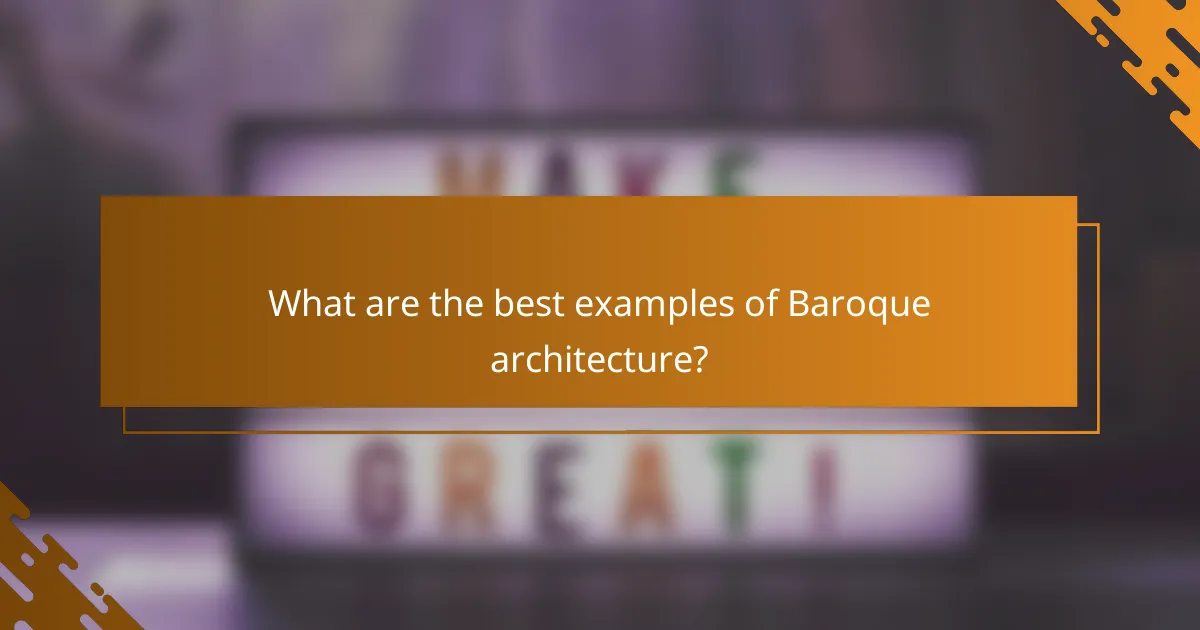
What are the best examples of Baroque architecture?
The best examples of Baroque architecture showcase grandeur, intricate details, and dramatic use of light and shadow. Key structures often embody the style’s emphasis on bold forms and elaborate ornamentation, making them significant in both historical and cultural contexts.
St. Peter’s Basilica in Vatican City
St. Peter’s Basilica is a quintessential example of Baroque architecture, designed by renowned architects including Michelangelo and Bernini. Its massive dome, which dominates the skyline, exemplifies the grandeur characteristic of the style, while the interior is adorned with lavish decorations and artworks that create a sense of awe.
Visitors to St. Peter’s Basilica can appreciate the harmonious blend of architecture and art, with features like the Baldachin by Bernini, which serves as a focal point above the papal altar. The use of light through the dome enhances the spiritual atmosphere, making it a must-see for those interested in Baroque design.
Palace of Versailles in France
The Palace of Versailles stands as a monumental representation of Baroque architecture, reflecting the absolute power of the French monarchy. Its grand façade, extensive gardens, and opulent interiors, such as the Hall of Mirrors, illustrate the style’s emphasis on luxury and theatricality.
When exploring the Palace, visitors can observe how the architecture integrates with the landscape, creating a seamless transition between the built environment and nature. The meticulous attention to detail in the decoration and layout serves as a testament to the Baroque era’s artistic ambitions and the desire to impress and overwhelm the viewer.
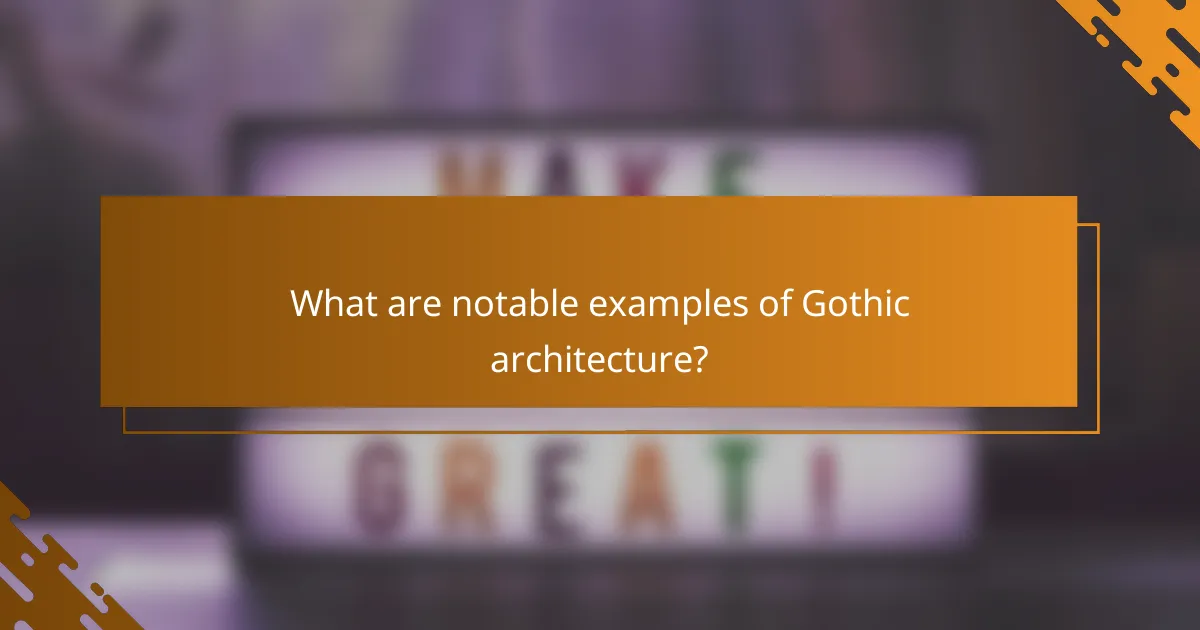
What are notable examples of Gothic architecture?
Notable examples of Gothic architecture showcase the style’s characteristic features, including pointed arches, ribbed vaults, and flying buttresses. These structures often emphasize verticality and light, creating an ethereal atmosphere within their interiors.
Notre-Dame Cathedral in Paris
Notre-Dame Cathedral is one of the most iconic examples of Gothic architecture, located on the Île de la Cité in Paris. Construction began in the 12th century and continued into the 14th century, resulting in a masterpiece that combines intricate sculptures, stunning stained glass, and soaring spires.
The cathedral’s flying buttresses not only provide structural support but also allow for large windows, filling the interior with natural light. Visitors often admire the famous rose windows, which are remarkable examples of medieval craftsmanship.
Chartres Cathedral in France
Chartres Cathedral, located in the town of Chartres, is renowned for its well-preserved Gothic architecture and stunning stained glass windows. Built in the early 13th century, it is a UNESCO World Heritage site and a prime example of the Gothic style’s evolution.
The cathedral features a unique blend of architectural elements, including a striking facade and two contrasting spires. Its labyrinth, located in the nave, offers a spiritual journey for pilgrims and visitors alike, reflecting the cathedral’s historical significance in medieval France.

How do Baroque and Gothic architecture influence interior design?
Baroque and Gothic architecture significantly shape interior design through their distinct styles and elements. Baroque emphasizes grandeur and drama, while Gothic focuses on verticality and light, influencing how spaces are perceived and utilized.
Baroque Architecture and Interior Design
Baroque architecture is characterized by opulence, intricate details, and a sense of movement. In interior design, this translates to lavish materials, bold colors, and ornate furnishings that create a dramatic atmosphere. Spaces often feature large mirrors, elaborate moldings, and grand chandeliers to enhance the sense of luxury.
When incorporating Baroque elements, consider using rich fabrics like velvet and silk, along with decorative accents such as gilded frames and baroque-style furniture. This approach works well in settings aiming for a luxurious, historical feel, such as hotels or upscale residences.
Gothic Architecture and Interior Design
Gothic architecture is known for its pointed arches, ribbed vaults, and flying buttresses, which contribute to a sense of height and light. In interior design, these features inspire the use of vertical lines, large windows, and a focus on natural light, creating airy and expansive spaces.
To evoke a Gothic style, consider incorporating dark wood, wrought iron, and stained glass elements. This style suits environments that desire a dramatic yet serene ambiance, such as churches, museums, or themed restaurants.
